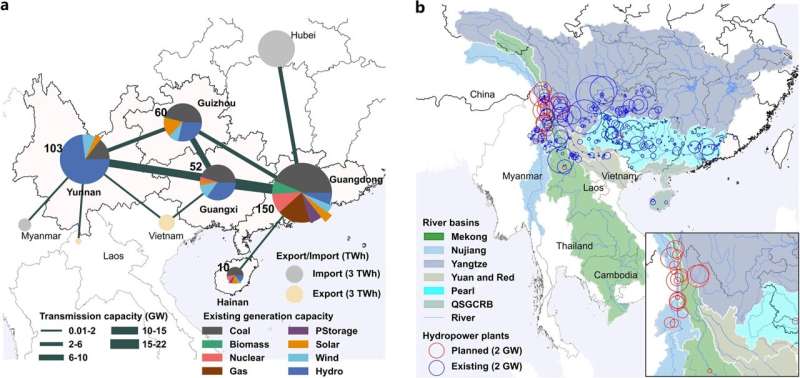This article has been reviewed according to Science X's editorial process and policies. Editors have highlighted the following attributes while ensuring the content's credibility:
fact-checked
peer-reviewed publication
trusted source
proofread
China's bid to decarbonize may have hidden costs

Environmentalists rejoiced when China announced its commitment to reach carbon neutrality by 2060, but the decarbonization of China—which emits 27% of global carbon dioxide and a third of the world's greenhouse gases—may come with hidden costs and hard environmental choices, according to new research.
In a paper published in Communications Earth & Environment, Stefano Galelli, associate professor in the School of Civil and Environmental Engineering, in Cornell Engineering, and colleagues attempt to quantify how decarbonizing the China Southern Power Grid, which provides electricity to more than 300 million people, will negatively impact river basins, most of which run from China into downstream countries, and will reduce the amount of cropland in China.
"If we think of any major technological change, they always have costs and unintended consequences," Galelli said. "The sooner we realize and address them, the more sustainable and equitable the energy transition will be. We have to do it right."
Decarbonizing the grid by 2060 may be technically feasible but would require building several dams for hydropower production (roughly 32 GW) and converting about 40,000 square kilometers of cropland to support growth in solar and wind, Galelli said. Most of the dams would be placed on transboundary rivers, meaning those shared by two or more countries, resulting in potential negative ecological impacts in both China and downstream countries.
"A fundamental problem is these dams will alter the river flow," Galelli said. "Changing the way water flows in the river has huge impacts on the riverine ecosystems and the communities that rely on them."
Two major transboundary river basins that will be impacted are the Salween and Mekong, both major biodiversity hotspots, Galelli said. The Salween is shared by China (upstream) and Myanmar; the Mekong by China (upstream), Myanmar, Thailand, Laos, Cambodia, and Vietnam—thus, the impacts of additional damming are shared.
As an example, he said, Cambodia's Lower Mekong Basin is the center of that country's inland fishing industry. Cambodia has one of the world's largest inland fisheries, a main source of protein for the population of 16.8 million. With more than 100 large hydropower dams already on the Mekong River and its tributaries, and several more planned or under construction, the implications associated with China building additional dams must be considered, Galelli said.
Dams block the transport of sediments and nutrients from the upper reaches to the river mouth, and this reduces the productivity of ecosystems and fisheries. Blocking the transport of sediments also affects river deltas: If sediments do not reach the delta, saline intrusion becomes a bigger problem. Dams can also impact migratory fish species.
"The costs may outstrip the benefits," he said. "It would be important to account for these impacts when planning large-scale decarbonization efforts."
Decarbonization would also lead to ecological and sociological trade-offs in terms of land use, he said.
China's President Xi Jinping has ramped up efforts and rhetoric around food security, emphasizing self-sufficient food production in lieu of relying so heavily on imports. But with 18% of the world's population and only 10% of the planet's arable land, that's a tall order—one made even tougher with more land given over to support solar and wind power.
"Excluding sites that are protected—cities and national parks, for instance—what you're left with is cropland on which to build solar and wind power," Galelli said.
And with China's electric vehicle industry seeing stratospheric growth—China now leads global electric vehicle sales—demand for electricity will continue to rise. Coal power plants have historically been the dominant source of electricity for the China Southern Power Grid—but building enough wind and solar arrays to replace the electricity supply guaranteed by conventional coal plants will take up a lot of space, Galelli said.
And that space required for the construction of solar and wind plants may not be equitably divvied up. Their research shows that 43% of the total land requirements would likely be focused on the Guangxi province, where crops and grassland constitute the vast majority of the land. This might be a heavy burden for the province and result in significant ecological, social, and financial costs to local communities.
Many new solar technologies are being developed, he said. Floating solar panels could cover some of the surface of lakes behind existing and planned dams (fully covering the surface of these lakes would impede their oxygenation). Solar on roofs is also viable, but in general represents a small amount of surface area and can be plagued by mechanical problems.
Galelli lists agrivoltaics, which combines solar with agricultural activities; carbon sequestration from gas and coal plants; more efficient batteries; and electricity demand management as other promising technologies.
"Our work is based on a projection of need in 2060, but need is not set or known, and 36 years is a lot of time for technical innovation," he said.
As we make strides toward decarbonizing, he said, China is at the forefront.
"Doing it in strategic ways is very important. We have to start with ones that are less impactful," Galelli said. "We can make decisions that balance decarbonization efforts with the protection of local communities, water and land resources."
More information: Xiaoyu Jin et al, China Southern Power Grid's decarbonization likely to impact cropland and transboundary rivers, Communications Earth & Environment (2024). DOI: 10.1038/s43247-024-01363-1
Journal information: Communications Earth & Environment
Provided by Cornell University





















